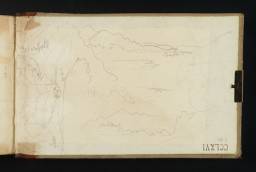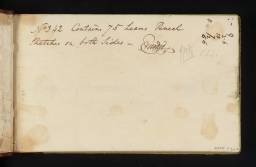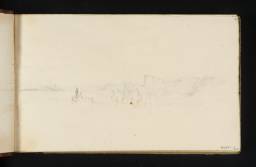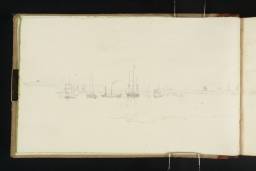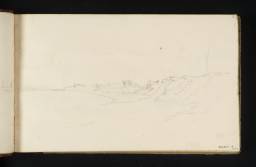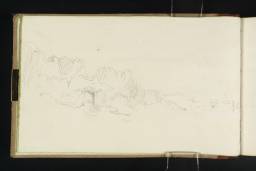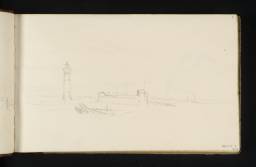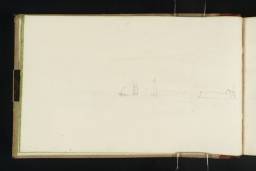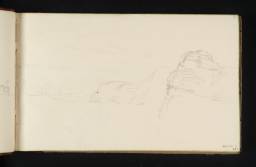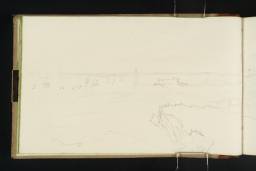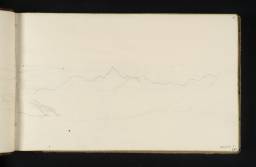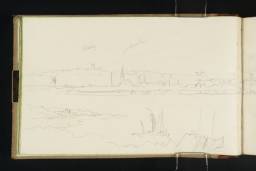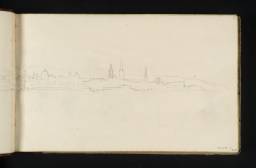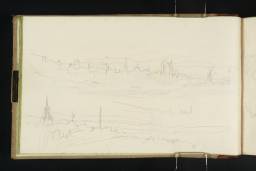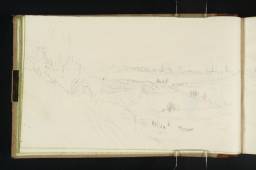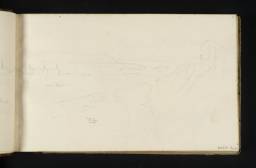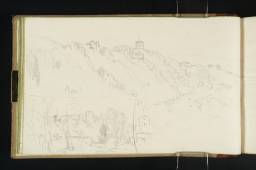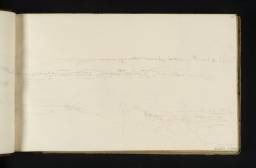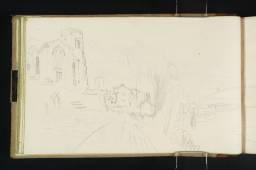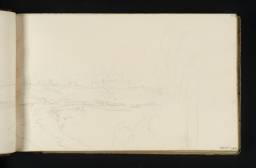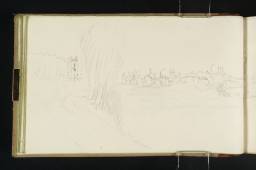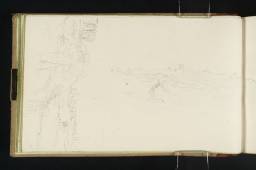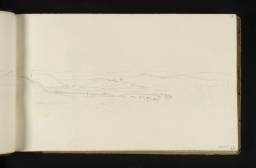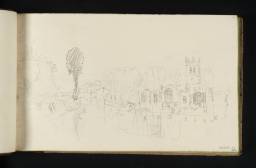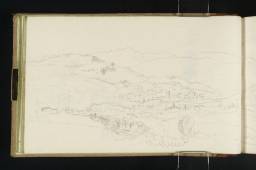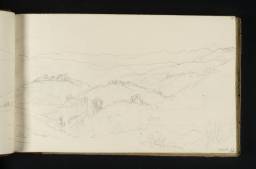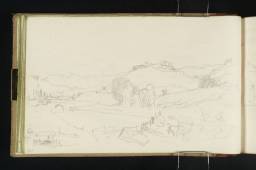Turner Bequest CCLXVI
Sketchbook bound in buff paper-covered boards with a brown leather spine, edges painted in green, and with one broken clasp. Rebound.
92 leaves of Post-Octavo white wove writing paper, the last eight of which were prepared on one side by Turner with a grey wash. Watermarked ‘J. JELLYMAN | 1828’ made by Joseph Jellyman at Downton Mill in Downton, Wiltshire. Approximate paper size 114 x 187 mm.
Stamped in black on the front cover ‘CCLXVI’ top right, and ‘CCLXVI’ on the back cover and the top left.
Numbered ‘589’ as part of the Turner Schedule 1854 and endorsed by the Executors of the Turner Bequest on folio 1 (D25762).
92 leaves of Post-Octavo white wove writing paper, the last eight of which were prepared on one side by Turner with a grey wash. Watermarked ‘J. JELLYMAN | 1828’ made by Joseph Jellyman at Downton Mill in Downton, Wiltshire. Approximate paper size 114 x 187 mm.
Stamped in black on the front cover ‘CCLXVI’ top right, and ‘CCLXVI’ on the back cover and the top left.
Numbered ‘589’ as part of the Turner Schedule 1854 and endorsed by the Executors of the Turner Bequest on folio 1 (D25762).
Accepted by the nation as part of the Turner Bequest 1856
Exhibition history
References
Although the Minstrelsy of the Scottish Borders sketchbook is the third of the 1831 tour books according to Finberg’s numbering – following Rokeby and Appleby (Tate D25524–D25643; D41065–D41067; Turner Bequest CCLXIV complete) and Berwick (Tate D25644–D25761; D41232–D41234; Turner Bequest CCLXV complete) – it was in fact the first that Turner employed in his tour, although he did use it alongside Rokeby and Appleby for some of the route.
The title was not Turner’s own; it is written nowhere in the book and, as Finberg noted, Turner’s spine label, if there ever was one, did not survive when the book was broken up by John Ruskin for exhibition.1 When Finberg listed the loose leaves of the book, they were held in three packages labelled ‘342. Scotland, 1st Packet’, ‘342. Scotland, 2nd Packet’ and ‘342. Inferior leaves’.2 The wording is typical of John Ruskin with his division of the sketchbooks in the Bequest into fine, middling and rubbish.3 Finberg therefore must have come up with the name which derives from the first four volumes of Scott’s Poetic Works, for which Turner was collecting subjects in Scotland and the north of England. Finberg was able to reconstruct the book in what seems to be the correct order thanks to the folio numbers that were inscribed in blue ink at the top right of each page, presumably by John Ruskin.
Sketching began in Liverpool with views of the shore around New Brighton and towards the Port of Liverpool. We know from a letter and Robert Cadell’s diary that Turner then travelled on to Manchester and Preston.4 It is possible that Turner reached Manchester by the new Liverpool-Manchester railway.5 There are sketches on the outskirts of Preston (folios 8–13; D25776–D25786) from where he went on to Kendal, where he sketched the church (folio 14; D25787) and castle (folio 15 verso; D25790). Sketching continued at Keswick and Derwentwater (folios 18 verso–24; D25795–D25807), with further Lake District views in the Rokeby and Appleby sketchbook. Near Penrith Turner made sketches of Mayburgh Henge for a Scott illustration (see folio 26 verso; D25812). He then took a detour east and Rokeby and Appleby became Turner’s main sketchbook with views of Appleby and the road on the way to Barnard Castle, Bowes and Rokeby to collect material for the Rokeby volume of Scott’s Poetical Works (volume 9).6 The Minstrelsy book, however, was used concurrently with sketches of Barnard Castle (folios 32; D25823), Bowes Castle (folios 31; D25821), Mortham Tower (folios 35 verso–36; D25830–D25831) and Egglestone Abbey (folio 33 verso; D25828).
Turner returned to Penrith, and Minstrelsy again became the principal sketchbook for the approach to Carlisle (folio 38 verso; D25836). From here Turner headed to the Scottish border and Dumfries (folios 55 verso–56; D25870–D25871) making trips from here to visit the ruins of Lincluden Collegiate Church (folio 53 verso; D25866) and Caerlaverock Castle (folio 49 verso; D25858). From Dumfries he headed east towards Lochmaben Castle (folio 57 verso; D25874), sketching the ruins of Torthorwald Castle on the way (folio 56 verso; D25872). He headed on to Lockerbie, and recorded the journey to Johnny Armstrong’s Tower in the Rokeby and Appleby book (Tate D25607; Turner Bequest CCLXIV 43), picking up the Minstrelsy book again for views of the tower in preparation for another illustration (folio 61; D25881). He then headed up the River Esk to Langholm (folio 63; D25885) and went north-east from there to to Hawick, taking in Hermitage Castle (folio 67; D25893), Branxholme Castle (folio 85 verso; D25914) and Goldielands Tower (folio 87 verso; D25918) on the way. From Hawick Turner coached to Abbotsford where he took up the Abbotsford sketchbook (Tate D25929–D26095; D40995–D40996 complete sketchbook; Turner Bequest CCLXVII).
Robert Cadell, ‘Abbotsford Diary’, 4 July 1831, National Library of Scotland, MS Acc.5188, Box 1, folio 102; transcribed in Gerald E. Finley, “J.M.W. Turner and Sir Walter Scott: Iconography of a Tour’, Journal of the Warburg and Courtauld Institutes, vol.35 (1972), p.377.
That Turner travelled to the Lake District before going east is proved by Cadell’s diary entry of 29 July in which he mentioned Turner sketching Skiddaw and ‘The Table Round’ (referring to Mayburgh) before he ‘retraced his steps so far for “Bowes Tower’ (National Gallery of Scotland, MS 3918, folio 204; cited in Gerald E. Finley, “J.M.W. Turner and Sir Walter Scott: Iconography of a Tour’, Journal of the Warburg and Courtauld Institutes, vol.35 (1972), p.363 note 36).
Technical notes
How to cite
Thomas Ardill, ‘Minstrelsy of the Scottish Border sketchbook 1831’, sketchbook, September 2009, in David Blayney Brown (ed.), J.M.W. Turner: Sketchbooks, Drawings and Watercolours, Tate Research Publication, December 2012, https://www

